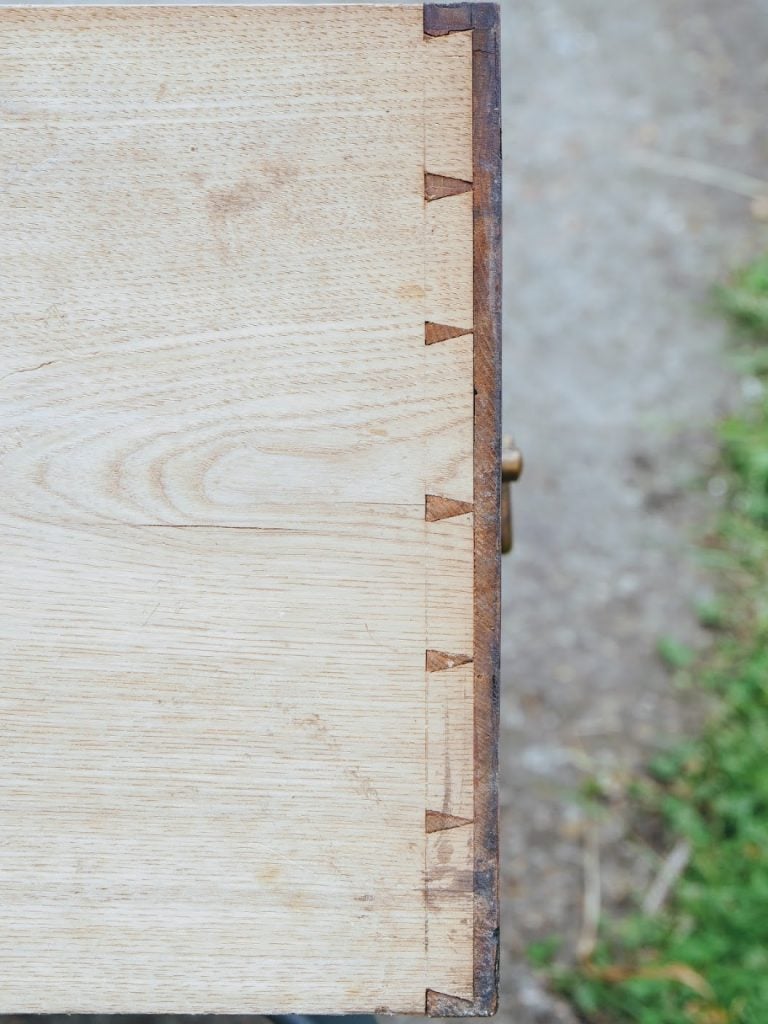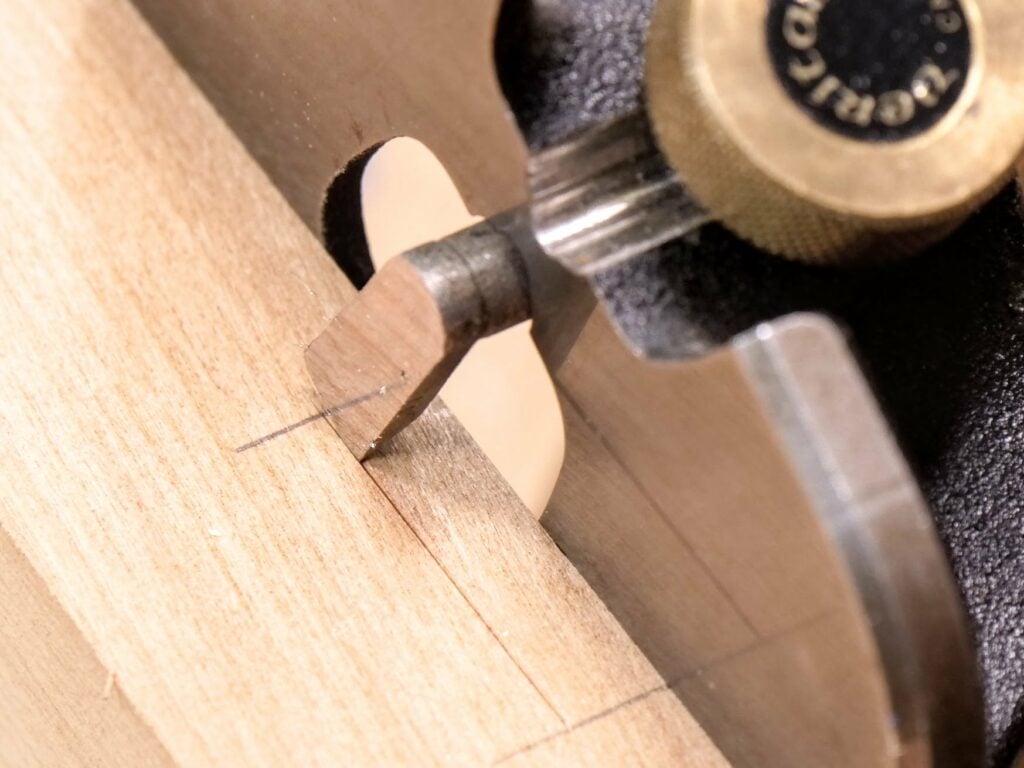Growing Intuition

Some people have asked why I don’t always use the hand router plane to surface my tenons to perfection after sawing or paring. It’s a good question and soon everyone will ask everyone one else why they don’t, taking it for granted that everyone does it that way. Well, it won’t be any different than those asking why not just use a power router or a tablesaw to do this or that. Some might be surprised to know that it was non standard before I introduced it. Fact is I never saw anyone else use the method. I never saw anyone use it as a marking gauge either, or a means for determining the depth of a housing dado to transfer cut lines or shoulder lines to adjoining pieces. Whether I invented the alternate uses is immaterial, I did develop systems using the hand router for different tasks and that’s all that matters to me. So why don’tI always use the hand router plane for skimming off the surfaces of my tenons? Well, I don’t need to. I can get it right straight off the chisel alone and if I stop relying in my intuitive development I might well lose the skills.

It’s the same for using a dovetail guide or guessing distances. For decades I have eyeballed most of the dovetail angles I made when making pieces for my customers. And not just the angles, I did the sizes of tails too. Two, three, four dovetails. It is super fast and if you look at most of the dovetails on early pieces they too were often eyeballed. We live in an era when we have the liberty to make and spend even an hour cutting a dovetail, the masters of old did not.It was eyeball or miss the deadlines and that meant no pay and no pay meant no food and clothing for the kids. I can usually guess any distance up to an inch and a half within 1/32″ and often I do do that. I can set the bandsaw blade to guesstimated distances and be on the mark. So I actually do that and then use the ruler to check myself. It’s very fast. When did I learn these things? When I was an apprentice.


An interesting point Paul. I always think it is key to not only exercise your skills in estimation but to test them regularly so you can learn from the feedback.
Funny Paul what you stated about the luxury of spending an hour on dovetails ( like me )…..recently I had the chance to dismantle an old drawer from a chest that was ready for the scrapheap. It must be well over 70 to 80 years old and I think possibly older. The drawers were relatively large and there were 5 dovetails per side. They looked perfectly well made when assembled but when I took the joint apart I noticed that the drawer front pins at the base were quite undercut and the level of finish on the internal joint was not the neatest. They were perfect when assembled though. I think whilst it is of course paramount to aim for fine craftsmanship and accuracy when learning I think I am guilty of demanding perfection when it may not be necessary. I made a small table recently and I was intentionally more ” loose ” with the unseen surfaces and to be honest when finished and polished it of course looked fine. It was actually difficult though when making it not to perfect everything. I saved quite a bit of time on the project and actually enjoyed the freedom a bit.
A retired cabinetmaker who spent his career in the “hand shops” around Hackney Road once told me that making 30 drawers in an afternoon by hand was not considered unusual. I fact, as they were paid piecework, they moved right along and didn’t bother too much about deeper-than-needed saw cuts, severe undercutting etc. Inaccurate jointing could be remedied with a few hammer blows followed by a quick slick with the plane. Another told me that when he worked for a firm in South London, jointing of long boards was done with glue only, “slapping” together the pieces. “If we had to use cramps, we got the sack.”
“. . . if I stop relying in my intuitive development I might well lose the skills.” That is exactly what is happening throughout our societies. Thanks for pointing it up.
I wonder whether you intend building your house full of furniture that way? Of course unlike the woodworkers of old I needn’t worry about my work being fast / affordable (beyond materials of course) but I am slow and it would take me a month of Sundays to build say a chest of drawers. As that would represent a significant proportion of my remaining life I have so far stuck to simpler things but even the young in need of furniture wouldn’t want to spend decades making do without. So it would be interesting and very useful to watch you ignore the legions of critical perfectionists who seem to inhabit the internet and show us the fast and dirty on a least a few pieces.
I believe the small differences introduced by “eyeballing” are responsible for our perception of something as organic vs. machined. Nature rarely does exactly the same thing twice.
That said, you are absolutely right about the need for experience to understand what is and is not critical for a tight joint. One of my mentors had a saying “do it my way until you get it right, then you can make a change if you see fit”. A great lesson, you need to prove you understand the “tradition” before inventing the future.
I had to smile when I read this because my first few dove tails made from scrap lumber were eyeballed to the angle and spacing and I remember thinking “why lay all this out “ when eyeballing was perfectly fine.
Its kind of funny how we strive for perfection, but when we go to look at antiques, we appreciate the uniqueness and character of things that are not perfect, like dovetailed drawers etc. Its similar to gardens. We try to buy a certain number of plants and space them a preset feet apart, etc, but when we go to a quirky English garden, we truly appreciate the uniqueness and natural look of things that seem randomly placed.
Paul,
I’m glad you raised this point also. You have done well to teach us techniques that will produce great tenons and dovetails but even as I work with my limited hand skills I notice that sometimes a chisel eye and hand alone gets me close enough. I’ve seen you cut 3 minute dovetails in old videos as well so I know you have all that intuition.
I’d like to see you do more hand work without the guides but more slowly and discussing what is going on in our head as you join boxes and rails. This might be for our more advanced lessons? The perfection of hand router tenons is really something but I doubt they are all that superior to cut and pared and there is a certain satisfaction in speed. As you have noted and although I have many machines I ask myself more and more if hand techniques are not actually faster for the 1 to 4 off kind of work I find myself doing. Frequently they are and unless I’m doing 4 or more of something I rarely turn on all the dust and noise but if I could be faster still?
I hope you can share what happens in your head when you are working with traditional techniques without the guides.
I build things for myself, my family, my enjoyment. I have power tools and hand tools and enjoy each tool for what its intention is. I recently graduated to being able to do acceptable dovetails by hand, which to me is a rite of passage.
I measure about 1/4″ from each edge for half-blinds, tick off three or four mid-marks with a divider and set pin width with a chisel, sliding the pencil down each side while I hold the chisel more or less centered over my mark. Get out the saw and start cutting.
It’s a Zen thing, I think. Once we get in the zone, it must release serotonin or something in the mind. Feels almost like runner’s high (I don’t run any more, too hard on the old knees).
There’s no hurry in my shop, since I do other things for a living. The hurry is to get out there and make something useful for the house, that will stand the test of time and look good doing it. I’ve been 40 years in aviation and am used to signing logbooks; I also sign my work when I’m done. It’s a thing… I certify I’m proud of this effort I’ve put into creating this piece and I’m signing my name to it, dadgummit! 🙂